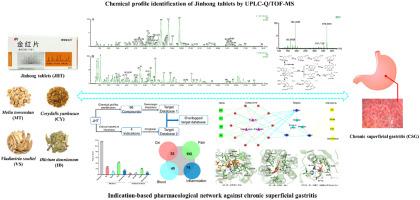Journal of Pharmaceutical Analysis ( IF 6.1 ) Pub Date : 2021-01-31 , DOI: 10.1016/j.jpha.2021.01.005 Danfeng Shi 1 , Lingxian Liu 1 , Haibo Li 2 , Dabo Pan 1 , Xiaojun Yao 3 , Wei Xiao 2 , Xinsheng Yao 1 , Yang Yu 1

|
Chronic superficial gastritis (CSG) is a common disease of the digestive system that possesses a serious pathogenesis. Jinhong tablet (JHT), a traditional Chinese medicine (TCM) prescription, exerts therapeutic effects against CSG. However, the molecular basis of its therapeutic effect has not been clarified. Herein, we employed ultra-performance liquid chromatography coupled with quadrupole time-of-flight tandem mass spectrometry (UPLC-Q/TOF-MS) based chemical profile identification to determine the chemical components in JHT. Further, we applied network pharmacology to illustrate its molecular mechanisms. A total of 96 chemical constituents were identified in JHT, 31 of which were confirmed using reference standards. Based on the bioinformatics analysis using the symptom-guided pharmacological networks of “chi,” “blood,” “pain,” and “inflammation,” and target screening through the interaction probabilities between compounds and targets, matrix metalloproteinase 2 (MMP2), dopamine d2 receptor (DRD2), and Aldo-keto reductase family 1 member B1 (AKR1B1) were identified as key targets in the therapeutic effect exhibited by JHT against CSG. Moreover, according to the inhibitory activities presented in the literature and binding mode analysis, the structural types of alkaloids, flavonoids, organic acids, including chlorogenic acid (10), caffeic acid (13), (−)-corydalmine (33), (−)-isocorypalmine (36), isochlorogenic acid C (38), isochlorogenic acid A (41), quercetin-3-O-α-l-rhamnoside (42), isochlorogenic acid B (47), quercetin (63), and kaempferol (70) tended to show remarkable activities against CSG. Owing to the above findings, we systematically identified the chemical components of JHT and revealed its molecular mechanisms based on the symptoms associated with CSG.
中文翻译:

通过化学特征鉴定和症状引导的网络药理学分析确定金红片抗慢性浅表性胃炎的分子基础
慢性浅表性胃炎(CSG)是一种消化系统常见疾病,具有严重的发病机制。金红片 (JHT) 是一种中药 (TCM) 处方,对 CSG 具有治疗作用。然而,其治疗效果的分子基础尚未阐明。在此,我们采用超高效液相色谱与四极杆飞行时间串联质谱 (UPLC-Q/TOF-MS) 为基础的化学谱鉴定来确定 JHT 中的化学成分。此外,我们应用网络药理学来说明其分子机制。JHT 共鉴定出 96 种化学成分,其中 31 种经参考标准物确认。基于“气”、“血”、“痛”等症状引导药理学网络的生物信息学分析,”和“炎症”,并通过化合物和靶点之间的相互作用概率进行靶点筛选,基质金属蛋白酶 2 (MMP2)、多巴胺 d2 受体 (DRD2) 和醛酮还原酶家族 1 成员 B1 (AKR1B1) 被确定为关键靶点。 JHT对CSG的治疗效果。此外,根据文献中提出的抑制活性和结合模式分析,生物碱、黄酮类化合物、有机酸的结构类型,包括绿原酸(10 )、咖啡酸( 13 )、(-)-紫檀香精( 33 )、(-)-异香豆素( 36 )、异绿原酸C( 38 )、异绿原酸A( 41 )、槲皮素-3- O - α - l -鼠李糖苷(42)、异绿原酸B(47)、槲皮素(63)和山柰酚(70)倾向于显示出显着的抗CSG活性。基于上述发现,我们系统地鉴定了 JHT 的化学成分,并根据与 CSG 相关的症状揭示了其分子机制。











































 京公网安备 11010802027423号
京公网安备 11010802027423号